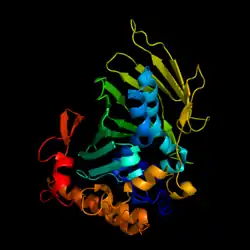Oxysterol-Binding Protein 1
Das Oxysterol-binding protein 1 (OSBP) ist ein Transportprotein für Lipide, vor allem für oxidierte Steroide.
| OSBP | ||
|---|---|---|

| ||
| nach PDB 4IC4 | ||
|
Vorhandene Strukturdaten: 4IC4 | ||
| Eigenschaften des menschlichen Proteins | ||
| Masse/Länge Primärstruktur | 807 Aminosäuren, 89.421 Dalton | |
| Sekundär- bis Quartärstruktur | Homodimer, homotrimer | |
| Bezeichner | ||
| Gen-Name | OSBP | |
| Externe IDs | ||
| Vorkommen | ||
| Homologie-Familie | Hovergen | |
Eigenschaften
OSBP1 ist im Cytosol eukaryotischer Zellen am Transport von Lipiden zwischen Golgi-Apparat und dem endoplasmatischen Retikulum beteiligt und bildet einen Lipidtransporter zwischen diesen Zellorganellen.[1][2] Dabei wird ein Oxysterol im Austausch gegen Phosphatidylinositol-4-phosphat (PI4P) an den Golgi-Apparat abgegeben.[3] Das PI4P wird anschließend im endoplasmatischen Retikulum durch die Phosphatase SAC1/SACM1L dephosphoryliert.[1]
OSBP bindet Cholesterol und eine Reihe von Oxysterolen einschließlich 25-Hydroxycholesterol.[4][5] Nach Bindung von Cholesterol werden PP2A und eine Tyrosinphosphatase gebunden zu einem Proteinkomplex, der ERK1 und ERK2 dephosphoryliert. 25-Hydroxycholesterol löst den Komplex wieder auf.[4] OSBP1 mindert die Stabilität von ABCA1 und reguliert dadurch die Exozytose von Cholesterol.[6] Die Genexpression von SREBP1c wird durch OSBP reguliert.[7] OSBP1 bindet auch an JAK2/STAT3.[8]
Regulation
OSBP1 wird durch die Proteinkinase D hemmend dephosphoryliert.[9] Ebenso wird die Aktivität von OSBP1 durch 25-Hydroxycholesterol gehemmt, OSBP1 wechselt im Anschluss vom Cytosol an die Membran des endoplasmatischen Retikulums.[10]
Struktur
OSBP1 besitzt die Proteindomänen Pleckstrin Homology Domain (PH) am N-Terminus, eine FFAT Domain (zwei Phenylalanine in einer Folge saurer Aminosäuren und eine ORD Domain am C-Terminus). Die PH bindet PI4P und GTP-gebundenes Arf1. Dadurch bildet OSBP1 eine molekulare Brücke zwischen ER und Golgi.[1] Die FFAT Domain bindet an VAP (vesicle-associated membrane protein associated protein).[11]
Isoformen
OSBP ist der erstbeschriebene Vertreter der OSBP-related Proteins (ORP), von denen Säuger 16 Isoformen besitzen. In Hefen kommen 7 Isoformen vor.[12]
Einzelnachweise
- B. Mesmin, J. Bigay, J. Moser von Filseck, S. Lacas-Gervais, G. Drin, B. Antonny: A four-step cycle driven by PI(4)P hydrolysis directs sterol/PI(4)P exchange by the ER-Golgi tether OSBP. In: Cell. Band 155, Nummer 4, November 2013, S. 830–843, doi:10.1016/j.cell.2013.09.056, PMID 24209621.
- M. Weber-Boyvat, W. Zhong, D. Yan, V. M. Olkkonen: Oxysterol-binding proteins: functions in cell regulation beyond lipid metabolism. In: Biochemical pharmacology. Band 86, Nummer 1, Juli 2013, S. 89–95, doi:10.1016/j.bcp.2013.02.016, PMID 23428468.
- V. M. Olkkonen: OSBP-Related Protein Family in Lipid Transport Over Membrane Contact Sites. In: Lipid insights. Band 8, Suppl 1 2015, S. 1–9, doi:10.4137/LPI.S31726, PMID 26715851, PMC 4685180 (freier Volltext).
- Ping-yuan Wang, Jian Weng, Richard G. W. Anderson: OSBP Is a Cholesterol-Regulated Scaffolding Protein in Control of ERK1/2 Activation. In: Science. Band 307, Nr. 5714, 4. März 2005, S. 1472–1476, doi:10.1126/science.1107710 (PDF).
- M. Suchanek, R. Hynynen, G. Wohlfahrt, M. Lehto, M. Johansson, H. Saarinen, A. Radzikowska, C. Thiele, V. M. Olkkonen: The mammalian oxysterol-binding protein-related proteins (ORPs) bind 25-hydroxycholesterol in an evolutionarily conserved pocket. In: Biochemical Journal. Band 405, Nummer 3, August 2007, S. 473–480, doi:10.1042/BJ20070176, PMID 17428193, PMC 2267293 (freier Volltext).
- K. Bowden, N. D. Ridgway: OSBP negatively regulates ABCA1 protein stability. In: The Journal of biological chemistry. Band 283, Nummer 26, Juni 2008, S. 18210–18217, doi:10.1074/jbc.M800918200, PMID 18450749.
- D. Yan, M. Lehto, L. Rasilainen, J. Metso, C. Ehnholm, S. Ylä-Herttuala, M. Jauhiainen, V. M. Olkkonen: Oxysterol binding protein induces upregulation of SREBP-1c and enhances hepatic lipogenesis. In: Arteriosclerosis, thrombosis, and vascular biology. Band 27, Nummer 5, Mai 2007, S. 1108–1114, doi:10.1161/ATVBAHA.106.138545, PMID 17303778.
- G. R. Romeo, A. Kazlauskas: Oxysterol and diabetes activate STAT3 and control endothelial expression of profilin-1 via OSBP1. In: The Journal of biological chemistry. Band 283, Nummer 15, April 2008, S. 9595–9605, doi:10.1074/jbc.M710092200, PMID 18230613.
- S. Nhek, M. Ngo, X. Yang, M. M. Ng, S. J. Field, J. M. Asara, N. D. Ridgway, A. Toker: Regulation of oxysterol-binding protein Golgi localization through protein kinase D-mediated phosphorylation. In: Molecular biology of the cell. Band 21, Nummer 13, Juli 2010, S. 2327–2337, doi:10.1091/mbc.E10-02-0090, PMID 20444975, PMC 2893995 (freier Volltext).
- N. D. Ridgway, P. A. Dawson, Y. K. Ho, M. S. Brown, J. L. Goldstein: Translocation of oxysterol binding protein to Golgi apparatus triggered by ligand binding. In: Journal of Cell Biology. Band 116, Nummer 2, Januar 1992, S. 307–319, PMID 1730758, PMC 2289278 (freier Volltext).
- S. E. Kaiser, J. H. Brickner, A. R. Reilein, T. D. Fenn, P. Walter, A. T. Brunger: Structural basis of FFAT motif-mediated ER targeting. In: Structure (London, England : 1993). Band 13, Nummer 7, Juli 2005, S. 1035–1045, doi:10.1016/j.str.2005.04.010, PMID 16004875.
- V. M. Olkkonen, T. P. Levine: Oxysterol binding proteins: in more than one place at one time? In: Biochemistry and cell biology = Biochimie et biologie cellulaire. Band 82, Nummer 1, Februar 2004, S. 87–98, doi:10.1139/o03-088, PMID 15052330 (Review).